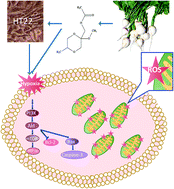Bioactive compound from the Tibetan turnip (Brassica rapa L.) elicited anti-hypoxia effects in OGD/R-injured HT22 cells by activating the PI3K/AKT pathway†
Abstract
Cerebral stroke, a common clinical problem, is the predominant cause of disability and death worldwide. Its prevalence increases and infarctions exacerbate with age. A Tibetan plant, Brassica rapa L., possesses multiple medicinal effects, such as anti-altitude sickness, anti-hyperlipidemia and anti-fatigue, as mentioned in the noted ancient Tibet pharmacopeia “The Four Medical Tantras”. Our preliminary studies also showed the anti-hypoxia protection mechanism of B. rapa L., implying its possible relationship with anti-ischemic neuroprotection. However, the potential molecular mechanism of the active constituent of turnip against cerebral ischemia/reperfusion remains unclear. In our study, oxidative stress markers, including LDH, ROS, SOD, GPx and CAT were assayed. In controlled in vitro assays, we found that the turnip's active constituent had remarkable anti-hypoxia capability. We further showed the profound effects of the active constituent of turnip on the levels of apoptosis-related proteins, including Bax, Bcl-2 and caspase-3, which contributed to its anti-inflammatory activity. Western blot analysis results also implied that active-constituent pretreatment reversed the diminished expression of the PI3K/Akt/mTOR pathway mediated by oxygen glucose deprivation/reperfusion (OGD/R); further experimental evidence showed that the protective role was limited in the PI3K inhibitor (LY294002) treatment group. Our results demonstrated that the functional monomer of B. rapa L. exerted a neuroprotective effect against OGD/R-induced HT22 cell injury, and its potential mechanism provides a scientific basis for future clinical applications and its use as a functional food.



 Please wait while we load your content...
Please wait while we load your content...